May 4, 2024 | 18:57 GMT +7
May 4, 2024 | 18:57 GMT +7
Hotline: 0913.378.918
May 4, 2024 | 18:57 GMT +7
Hotline: 0913.378.918
According to the Department of Crop Production, the total rice farming area in the South Central Coast region is estimated at more than 531,000 hectares, accounting for 7.3% of the country’s total rice farming area. The average rice yield in the region reached more than 6.1 tons/ha, 3.8% higher than the national average rice yield.
In recent times, the trend of industrial development has attracted many rural workers, so in the sowing or harvesting season, rural areas often encounter difficulty in labor, leading to untimely harvesting. Thereby, the loss rate in the field is high, and product quality is also reduced.

Farmers visit a rice production model applying the integrated farming technical package in the direction of reducing input costs in Tay Binh commune (Tay Son district, Binh Dinh). Photo: D.T.
To overcome the labor shortage in rice production, it is necessary to apply mechanization from production to harvesting and processing to reduce input costs and improve production efficiency. In recent years, provinces in the South Central Coast region have begun to promote the application of mechanization in rice production.
To adapt to climate change and contribute to reducing input costs in rice production, the Agricultural Sciences Institute for Southern Coastal Central of Vietnam (ASISOV) has recently implemented many rice production models applying the integrated farming technical package towards reducing input costs in An Nhon town, Phu Cat district, Tay Son district (Binh Dinh), and Tay Hoa and Phu Hoa districts (Phu Yen).
In the summer-autumn crop of 2023, ASISOV has built in Tay Binh commune (Tay Son district, Binh Dinh) a rice production model applying the integrated farming technical package to reduce input costs on an area of 30 hectares, cultivating the pure-bred rice variety BĐR999.
According to MS. Nguyen Duc Tho, Head of the Department of Technology Transfer and Agricultural Extension (under ASISOV), the project "Building a rice farming model towards reducing input costs in some South Central Coast provinces" aims to transfer to farmers new production methods and synchronous application of integrated farming technical solutions in rice production.
Through the project, ASISOV has transferred to farmers scientific and technological solutions that have been applied synchronously, such as: using new varieties; reducing the amount of seeds by applying row or cluster sowing methods instead of manual sowing as before. Increasing fertilizer use efficiency by applying balanced fertilizers, using new generation fertilizers, and making full use of agricultural scraps and by-products to improve soil. Watering and using pesticides appropriately. Mechanization in tillage and harvest will reduce input costs by at least 15%. Production adaptation to climate change contributes to improving efficiency and developing sustainable rice production in the South Central Coast provinces.
Nguyen Duc Tho said that applying advanced rice farming technical processes helps reduce the amount of seeds sown by 50%, the amount of nitrogen fertilizer by 22–34.5%, pesticide costs by 30–50%, and irrigation water per crop by 27–30%, and increases productivity by an average of 7%.
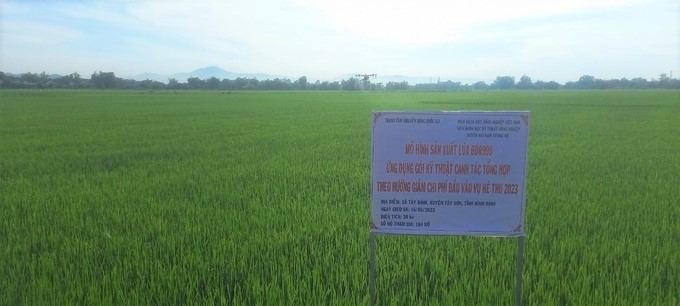
The model applies the advanced rice farming technical process in Tay Binh commune (Tay Son district, Binh Dinh) when the rice is still green. Photo: D.T.
When applying the advanced rice farming technical process, production costs were reduced by 10–12%, and economic efficiency increased by 38% compared to the farming process commonly applied by farmers. In particular, the advanced production process reduced equivalent emissions by 814–937.5 kg CO2e/ha/crop compared to the control model.
Applying the advanced farming technical package, farmers use certified seeds and sow at a density of 70 kg/ha by cluster seeders or row-seeding with row-sowing tools. Apply balanced fertilizer according to the needs of rice; avoid over-fertilizing with nitrogen; and implement integrated pest management measures to reduce the use of pesticides and use pesticides with active elements on the list of permitted uses. Manage water by alternating wet and dry irrigation or cutting water supply at times when rice does not need much water.
Mr. Nguyen Dang Suong, Vice Chairman of the People's Committee of Tay Binh commune (Tay Son district, Binh Dinh), assessed that although implementing the advanced farming process reduced the amount of seeds sown compared to traditional production practices (from 160 kg/ha to 120 kg/ha), thanks to effective ear, the number of firm seeds or ears is higher than the control variety, and the imperfect grain rate is 3.7% lower than the control variety. Therefore, the fields in the model are more productive than fields outside the model. The yield of the BĐR999 rice variety in the model is expected to reach 7.17 tons/ha, 0.18 tons/ha higher than the control rice variety.
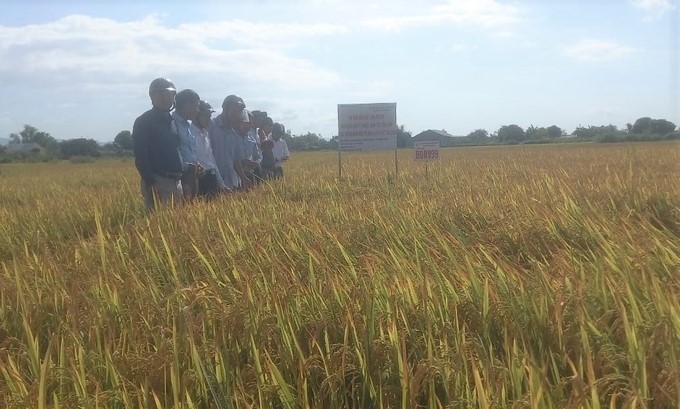
BÐR999 rice in the model field has a higher yield than the field outside the model by 0.18 tons/ha. Photo: D.T
Mr. Vuong Van Dong, Director of Tay Binh Agricultural Cooperative, calculated: The total cost of the model field is more than VND 34 million/ha, while the cost of the field outside the model is nearly VND 38 million/ha. The total income of the field in the model is nearly VND 59 million/ha, while the income of fields outside the model is just over VND 57 million/ha. Thus, the model field has a net profit of more than VND 24.6 million/ha, while the model fields outside the model have a net profit of just over VND 19.6 million/ha. The profit of the model field increases by more than 20% compared to the control field.
"Using the new rice variety BÐR999 along with integrated intensive farming techniques has brought a high yield of rice, contributing to increasing output and income for farmers," Mr. Dong assessed.
“The yield of the pure-bred rice variety BĐR999 in the model reached nearly 7.2 tons/ha, higher than that of the control variety Q5 of 0.19 tons/ha, an increase of over 16.3% compared to the project's goal of 6.5 tons/ha. The net profit of the field in the model reached more than VND 24.6 million/ha, an increase of more than 20% compared to the Q5 rice field of the control field, reaching the set target.
With the above results, in the coming years, we recommend localities in Binh Dinh replicate the model so that farmers can access and widely apply the integrated farming technical package towards reducing input costs to improve rice productivity, reduce labor, and bring high economic efficiency," said MS. Nguyen Duc Tho.
Translated by Huyen Vu Thu
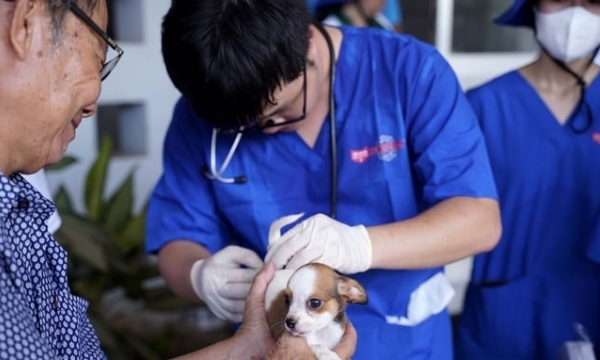
(VAN) Pet owners in Long An province exhibit indifference and a lack of understanding regarding rabies. They maintain the misconception that pet dogs and cats are immune to the disease.
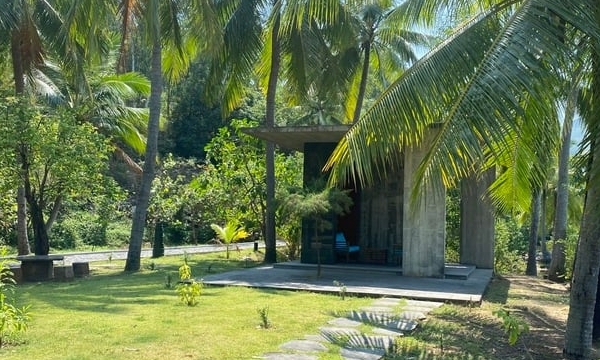
(VAN) The STAR-FARM project is funded by the European Union and implemented in the provinces of Dong Thap, Kien Giang and Tra Vinh, with a total investment of 4.2 million Euro.
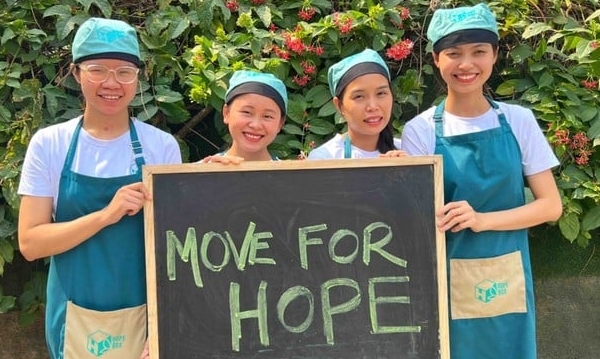
(VAN) The ecosystem and social impact business organizations (SIBs), although still modest in number, is very diverse and dynamic, they have been creating positive changes in many aspects, contributing to building a sustainable future
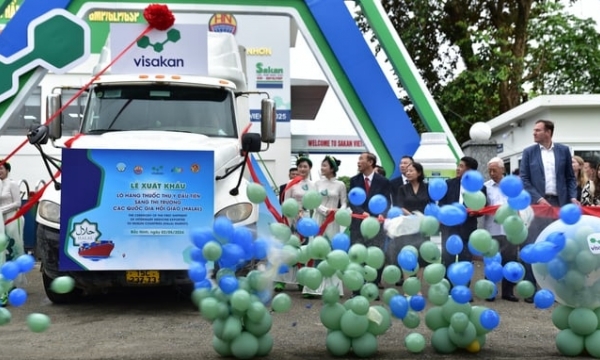
(VAN) Visakan Biotechnology Development Investment Company, a subsidiary of Hung Nhon Group, recently held a ceremony to commemorate its first export shipment of veterinary medicine to the Halal market.
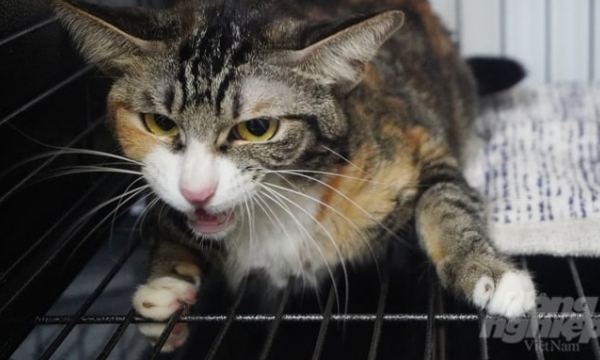
(VAN) If temporary regulations on dog and cat ownership are approved, Ho Chi Minh city will pilot the implementation of microchipping for dogs and cats in several designated areas within the inner city.
/2024/05/02/5303-5730-6-185654_281.jpg)
(VAN) Dr. Pham S, Vice Chairman of Lam Dong Provincial People's Committee: 'Lam Dong has attracted 80 FDI enterprises and 1,550 domestic enterprises to invest in agricultural development, with 150 agricultural cooperatives applying high technology'.
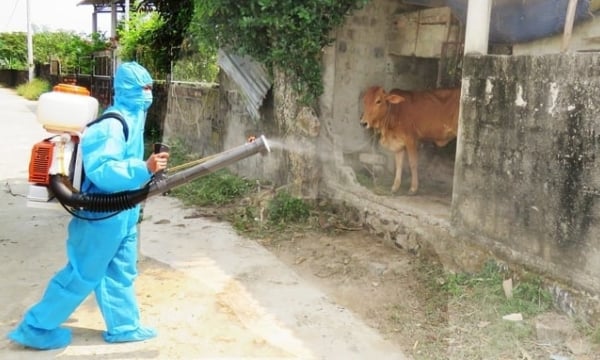
(VAN) An outbreak of Lumpy Skin Disease has occured across four districts in Quang Binh province, prompting local veterinary forces to strengthen prevention efforts.